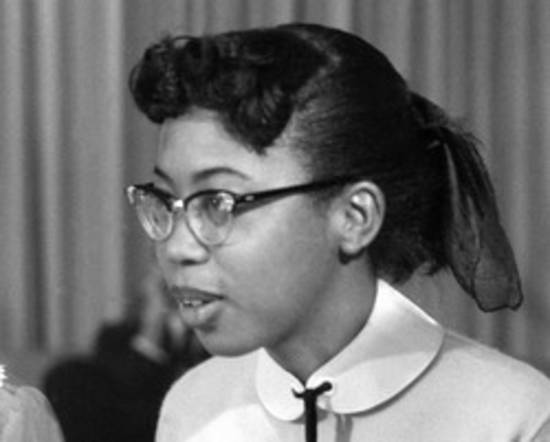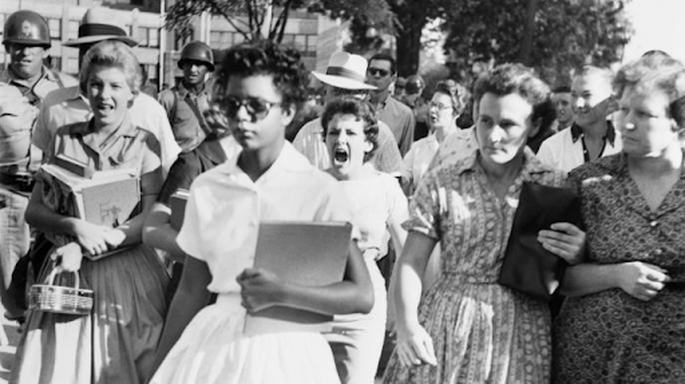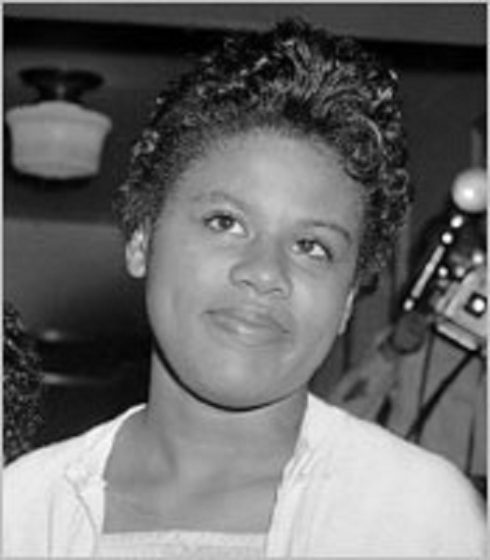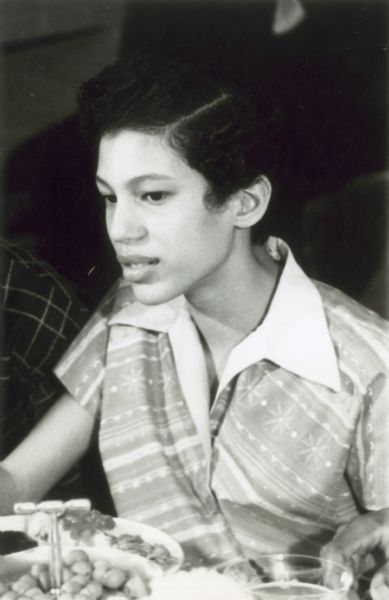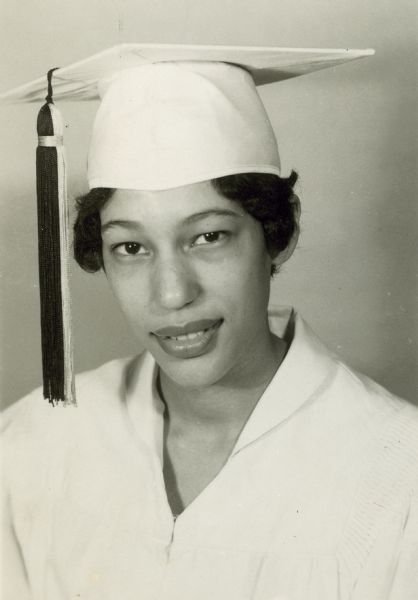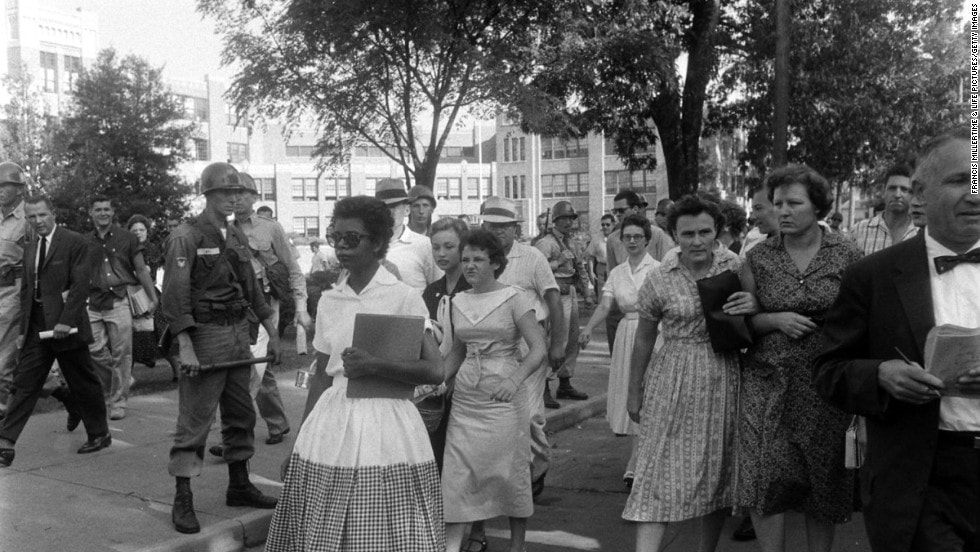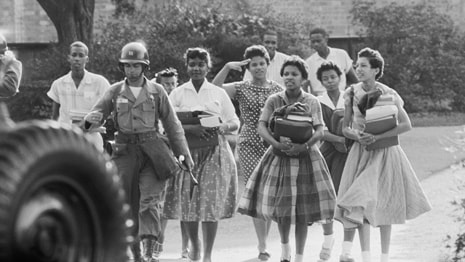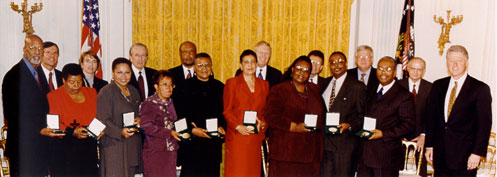|
Thelma Mothershed Wair attended Little Rock Central High School for her junior year. Since Governor Faubus closed all of Little Rock’s high schools the following year to prevent integration, Wair attended summer school and took correspondence courses to earn the credits necessary for a high school diploma. She then earned her Bachelor of Arts in Home Economics, her Master of Science in Guidance and Counseling Education, and an administrative certificate in Education at Southern Illinois University. Wair then spent 28 years of her career as a home economics teacher. When reflecting on her time as an educator, Wair stated “I was determined to treat my kids equally” (Wair). This determination likely stemmed from her experiences directly combating unequal treatment of students. She also taught survival skills to women at a Red Cross homeless shelter and worked at a juvenile detention center. Wair has received recognition for her teaching and involvement in the Civil Rights Movement. She was recognized as an Outstanding Role Model by the Top Ladies of Distinction in east St. Louis and the early childhood/pre-kindergarten of her school district. The National Association for the Advancement of Colored People awarded her the Spingarn Medal. She also earned the Congressional Gold Medal, which she received from President Clinton. Both as a student and a teacher, Thelma Mothershed Wair embodies the concept of equality in schools. For more on Ms. Watershed Wair, please see: https://ualr.edu/race-ethnicity/thelma-mothershed-wair-the-little-rock-nine http://www.encyclopediaofarkansas.net/encyclopedia/entry-detail.aspx?entryID=724
1 Comment
Kelly Coltrain, a twenty-seven year old woman, was incarcerated in a Nevada county jail because she did not pay her traffic tickets on time. Feeling unwell, she asked to go to the hospital. As her condition worsened instead of being allowed treatment she was handed a mop and instructed to clean up her own vomit. She died less than an hour later. Even after a deputy noticed she was unresponsive no medical personnel were brought to the scene, and she lay dead in her cell for hours.
For more on this tragic, avoidable incident please see: https://www.usatoday.com/story/news/nation-now/2018/09/02/texas-woman-died-denied-treatment-jail/1182381002/ Elizabeth Eckford was the only member of the Little Rock Nine to arrive at the first day of school alone. The night before, following the announcement that the National Guard would be at Central High, it was arranged for all of the African American students to arrive at school together. However, Eckford’s family did not own a phone, so she was not informed of the new plan. She recalls that “The night before when the governor went on television and announced that he had called out the Arkansas National Guard, I thought he had done this to insure the protection of all the students” (Eckford). She was unaware of the fact that the National Guard was actually called in to prevent the African American students from entering the school. When she arrived alone, she was harassed and threatened by the mob that surrounded the school. White people called for her to be lynched, told her to go back to Africa and yelled racial slurs at her. When she attempted to enter the school, members of the National Guard prevented her from doing so. It was only after being denied entry by several troops that she realized the real reason for the National Guard’s presence. Although federal troops were eventually sent in to ensure that the African American students could attend school and protect them, the students still faced harassment and violence constantly. For example, during school, white students threw vegetables and eggs at Eckford, spat on her, and punched her. Even though the African American students were abused at Central High, Arkansas Governor, Orval Faubus, still could not stand to see them at Central High. As a result, he decided to close all of the city’s high schools to stop racial integration from occurring. The schools eventually reopened and were required to integrate, but Eckford did not return. She took night courses and correspondence courses, earning enough credits to graduate without returning to Central High. She then attended Knox College and Central State University, graduating with a Bachelor of Arts in History. She later went on to serve in the U.S. Army for five years as a pay clerk and later as an information specialist. Unfortunately, Eckford has faced depression and trauma throughout her life as a result of the abuse she endured while attending Little Rock Central High School.
Elizabeth Eckford has received numerous awards for her courage and bravery as a member of the Little Rock Nine. She received the Spingarn Medal from the National Association for the Advancement of Colored People. She also earned the Father Joseph Blitz Award from the National Conference for Community and Justice. Furthermore, she was presented with the Congressional Gold Medal by President Clinton. Eckford also wrote a book entitled The Worst First Day: Bullied while Desegregating Central High. Elizabeth Eckford is celebrated for the enormous role she played in the Civil Rights Movement. The haunting image of Eckford being screamed at by white people brought international attention to the issue of American racial segregation. Jefferson Thomas was 15 years-old when he started at Little Rock Central High School. He volunteered to attend the previously all-white school because he knew that it offered better educational opportunities than the African American school he previously attended. He and the other members of the Little Rock Nine were initially prevented from attending Central High because angry mobs and the Arkansas National Guard denied them entry to the school because they were African American. After several weeks, the students were eventually able to attend because federal troops were sent in to protect them. Thomas and the other students faced constant harassment and violence from their white classmates. The white students always stared at Thomas, but he claimed “That’s natural that somebody is going to stare...It’s like kids going to a circus for the first time and seeing an elephant there. They stare” (Thomas). Aside from being stared at, Thomas was subjected to far worse abuse. One time, a white student punched him from behind, knocking him out. He was so fearful for his safety that every day when school ended, he ran home rather than walked. He also needed protection so one of his older brothers would wait for him when school got out, holding a tire iron in case he needed to defend his brother. Thomas endured constantly feeling unsafe because “If one of us had quit, that would have shown a weakness in our unity” (Thomas). Thomas was one of the three members of the Little Rock Nine to graduate from Central High School. After graduating, he began college at Wayne State University, then transferred to Los Angeles State College, where he was president of the Associated Engineers and he was involved in student government. He then went on to serve in the U.S. Army during the Vietnam War. After serving, he returned to Los Angeles State College, where he earned a degree in Business Administration. Thomas worked as an accountant for the remainder of his career and eventually worked for the Department of Defense. Thomas has been recognized for his commitment to racial equality. He received the Spingarn Medal from the National Association for the Advancement of Colored People in 1958. He also earned the Congressional Gold Medal, the highest award that can be given to a civilian, from President Clinton in 1999. Thomas was also presented with an honorary Doctorate of Humane Letters from Ohio Dominican University. Jefferson Thomas died from pancreatic cancer on September 5, 2010. He was the first member of the Little Rock Nine to pass away. The other members of the group remember Thomas for his sense of humor. The country remembers him as an important figure in the Civil Rights Movement. President Obama stated “Mr. Thomas was just a teenager when he became one of the first African-American students to enroll in Little Rock Central High School. Yet even at such a young age, he had the courage to risk his own safety, to defy a governor and a mob, and to walk proudly into that school even though it would have been far easier to give up and turn back” (Obama).
Minnijean Brown Trickey was 15 years-old when she started at Little Rock Central High School. She registered to attend Central High after she heard an announcement about having the ability to do so on the intercom at her school at the time, Horace Mann School for African-Americans. The main motivation behind her decision to switch schools was that Central High was walking distance from her house and Horace Mann was across town and did not provide any transportation services. When Trickey was preparing to start at Central High, she didn’t expect much of a reaction to herself and the other African American students. Unfortunately, the reaction of racist white people was larger than anyone could have expected. From before they were able to step foot in the door through when they left Central High, the Little Rock Nine endured constant abuse in many forms. Trickey explained that “The abuse actually escalated over time because the 101st left, and it never ever calmed down. It didn’t suddenly become nice, it didn’t suddenly become pleasant; it was constant” (Trickey). For example, there was a group of girls who frequently spat on her, stepped on her heels and harassed her. One day, Trickey had enough of the abuse. The girls threw a purse at her in homeroom and Trickey told them to leave her alone and called them white trash. As a result, she was suspended and later expelled from Central High School. When she was leaving, white students passed around cards that stated “One down, eight to go.” After she was expelled from Central High, Dr. Kenneth Clark and Dr. Mamie Clark, African American psychologists, invited Trickey to live with them in New York City. These doctors conducted research that produced the now famous “doll tests” that showed how racial segregation negatively impacted African American children. The doll tests were used in and influenced the outcome of Brown v. Board of Education of Topeka. In New York, Trickey attended and graduated from the New Lincoln School, a school that specialized in the arts. She then went on to study journalism at Southern Illinois University. Over time, Trickey continued to express strong commitment to her values. One example that showed this commitment was when she moved to Canada to protest the Vietnam War. In Canada, she earned both bachelors and masters degrees in social work. After returning to the U.S., she was a Deputy Assistant Secretary for Workforce Diversity at Department of the Interior under the Clinton administration. Currently, Minnijean Brown Trickey is still extremely involved in social activism. She works in relation to issues such as the environment, peacemaking and youth leadership. One of Trickey’s favorite moments was when she spoke at an award ceremony for Malala Yousafzai, a young woman who was shot in the head by the Taliban because she advocated for women to be educated. Trickey sees herself and the Little Rock Nine in Malala. Both Malala and the Little Rock Nine stood up for their right to education and were abused as a result. When reflecting back on everything she endured as one of the Little Rock Nine, Minnijean Brown Trickey stated that “It wasn’t pleasant but it had to be done. I don’t regret it” (Trickey). For more information on Ms. Trickey, please see:
https://www.smithsonianmag.com/smithsonian-institution/member-little-rock-nine-discusses-her-struggle-attend-central-high-180958870/ http://www.encyclopediaofarkansas.net/encyclopedia/entry-detail.aspx?entryID=720 https://www.thirteen.org/unsungheroines/women-cat/minnijean-brown-trickey-environmental-and-civil-rights-activist/ Carlotta Walls LaNier was the youngest member of the Little Rock Nine. She was only 14 years-old when she endured hatred and violence at Little Rock Central High School. She enrolled at Central High because she was inspired by Rosa Parks’ refusal to give her bus seat to white bus riders and she was determined to receive the best education possible. Since Central High was known as the most prestigious high school in Little Rock and African Americans could now legally attend, LaNier wanted to take advantage of the opportunity before her. LaNier was so determined to receive quality education that she registered to attend Central High without informing her parents. Her parents only realized what she had done when her registration card arrived in the mail the summer before she began school there. Her parents were proud that she made such an independent and brave decision on her own. When she attended Central High School, LaNier was spit on, harassed and threatened regularly. LaNier was one of the three members of the Little Rock Nine to return to Central High School and graduate after Governor Faubus closed all of the city’s schools to prevent integration. The constant challenges and hardships she faced at Central High made graduating worthwhile. When referring to her diploma, she stated “I had to have that sheet of paper...It was an achievement. I helped change the educational system” (LaNier). After becoming the first African American woman to graduate from Little Rock Central High School, LaNier attended Michigan State University and later transferred to the University of Northern Colorado, where she received her Bachelor of Science degree in 1968. LaNier currently serves as President of the Little Rock Nine Foundation. This organization provides mentoring and financial aid to students of color to help them gain equal access to education. Due to her role as a member of the Little Rock Nine and her influence on the Civil Rights Movement, Carlotta Walls LaNier has received the following awards and recognition: the Congressional Gold Medal from President Clinton, the Spingarn Medal from the National Association for the Advancement of Colored People, the Lincoln Leadership Prize from the Abraham Lincoln Presidential Library Foundation, four honorary doctorate degrees, a personal invitation to President Obama’s inauguration, and inductions into the Colorado Women’s Hall of Fame as well as the National Women’s Hall of Fame. LaNier also published a memoir entitled A Mighty Long Way: My Journey to Justice at Little Rock Central High School. Carlotta Walls LeNier is celebrated for the enormous role she played in the fight for racial integration. For more information on Ms. LaNier, please see:
https://www.smithsonianmag.com/smithsonian-institution/youngest-little-rock-nine-speaks-about-holding-onto-history-180964732/ https://www.womenofthehall.org/inductee/carlotta-walls-lanier/ http://www.cpr.org/news/story/carlotta-walls-lanier-reflects-on-60-years-since-the-little-rock-nine https://ualr.edu/race-ethnicity/carlotta-walls-lanier-the-little-rock-nine/ http://www.thehistorymakers.org/biography/carlotta-walls-lanier-39 http://www.cogreatwomen.org/project/carlotta-lanier/ http://www.encyclopediaofarkansas.net/encyclopedia/entry-detail.aspx?entryID=729 http://time.com/4948704/little-rock-nine-anniversary/ https://myhero.com/Little_Rock_Nine_HSC_07 Today marks the 61st anniversary of the integration of Central High School in Little Rock, Arkansas. Throughout the week we will be publishing historical posts to commemorate this anniversary, starting today with an overview of the incident. On September 4, 1957, nine African American students attempted to attend a previously all-white high school in Little Rock, Arkansas, but were prevented from entering by an angry mob and the Arkansas National Guard. Three years after the U.S. Supreme Court ruled that racial segregation in public schools was unconstitutional, the South largely ignored the ruling and schools remained segregated. The nine African American students, known as the Little Rock Nine, challenged the South’s refusal to integrate and exercised their right to choose which high school they would attend. These students wanted to study at Little Rock Central High School because it was known as the city’s best high school and they now had the right to attend it. Pending the arrival of the nine African American students, on their first day, an angry mob of 400 people and 100 members of the Arkansas National Guard blocked the entrance to the school. The National Guard was called in by Arkansas Governor, Orval Faubus, for the purpose of preventing the African American students from entering the school. Faubus claimed that preventing the students from entering the school was for their own benefit and that violence could erupt if they were allowed to enter. His actions directly opposed a court order requiring the school to integrate. While the National Guard’s presence at Central High School was ordered by the state, an angry mob arrived on its own. Members of the mob uttered racist slurs, threw stones at the students and threatened to kill the students. Due to the horrible violence they faced, the students were forced to leave. A few weeks later, the students were able to return to Little Rock Central High School with help from the federal government. President Eisenhower was furious with the situation in Little Rock and stated “Mob rule cannot be allowed to override the decisions of the courts” (Eisenhower). Eisenhower sent 1,200 troops from the U.S. Army’s 101st Airborne Division to Little Rock to protect the African American students. On September 25, 1957, the presence of federal troops gave the students the ability to attend school. Each of the nine students were provided with a personal military escort for the rest of the school year. However, the troops were not allowed to enter classrooms, locker rooms or bathrooms, which left the African American students vulnerable to harassment, threats and violence in such locations. As a result, the students faced constant racism and abuse when they could not be protected by the troops. However, even though the federal government was heavily enforcing the court order requiring integration, Governor Faubus would not allow integration to occur. Faubus closed all three of Little Rock's high schools instead of integrating them. Arkansas’ governor chose to deny education to all of Little Rock’s high school students rather than allow racial integration. It wasn’t until 1960 that Central High School reopened as a desegregated institution. The Little Rock Nine are now known as extremely influential members of the Civil Rights Movement. They have received various awards and honors for their enormous impact. For example, each member of the group was awarded the Congressional Gold Medal by President Clinton in 1999. Each of them also received personal invitations to attend President Obama’s inauguration in 2009. Their courage to stand up for their constitutional rights and their bravery to challenge such brutal racism are now widely respected. For more information on the Little Rock Nine, please see: https://www.history.com/topics/black-history/central-high-school-integration http://time.com/4948704/little-rock-nine-anniversary/ https://www.britannica.com/topic/Little-Rock-Nine https://www.history.com/this-day-in-history/central-high-school-integrated The case stems from a fatal pursuit by the Gardena Police Department, where an officer vehicle struck the side of a pickup truck it was pursuing and killed a passenger. The State Supreme Court held that if a department requires all of their officers to be certified in policies relating to vehicle pursuits the department cannot be held liable even if not all of their police officers have in fact completed certification. Opponents of the decision worry that this destroys incentives for departments to actually comply with laws or policies requiring 100% certification.
For more information, see: www.latimes.com/local/lanow/la-me-ln-police-pursuit-court-20180813-story.html Lisa Mitchell, an African American transgender woman who has lived as a woman her entire life, was continually denied the critical hormone replacement therapy she needed. In October 2011, Mitchell was convicted of a crime and was sent to Wisconsin Columbia Correctional Institution where she would serve her 18-month sentence. A month after being in the Correctional Institution, Mitchell requested her hormone treatment. Because of the DOC’s guidelines and policies on Health Care Treatment for transgender inmates, her initial request was a multistep process, including an interview of Mitchell. Through the many steps that Mitchell had to go through to even request medical assistance for her hormone treatment, her interview did not occur until six months after her initial request for care. In the months leading up to the interview, Mitchell repeatedly asked her Psychologist for help and updates. Her Psychologist continually did not respond to her requests. In the meantime, Mitchell’s psychological health was deteriorating. In her mental health counseling appointments, the Psychologist was encouraged to focus on other mental health issues, not now Mitchell was responding in the wait for treatment. After over a year of waiting, Mitchell finally received the signatures necessary to start the hormone treatment. Though her file indicated that treatment was necessary, the medical officer, Dr. Kevin Kallas, refused to begin the treatment because Mitchell’s release was a month away. Once Mitchell was on parole for 18 months, she was prevented from expressing her gender identity and obtaining treatment. Her probation officers refused her treatment, despite her file stating that treatment was necessary and would reduce the risk from committing another crime. Ultimately, because the prison medical staff refused her treatment and she was refused treatment while on parole, Mitchell did not receive medical care and was discriminated against.
Once Mitchell finished her parole in 2015, Mitchell represented herself sued Dr. Kevin Kallas and Dr. Dawn Laurent along with three parole officers for denying her medical treatment under the Eighth Amendment. The United States District Court for the Western District of Wisconsin dismissed her claims against the parole agents without prejudice (meaning she can refile) ruling that she failed to state sufficient facts to sustain her Eight amendment claims. However the court determined that her claims against the two doctors were sufficiently pled and allowed them to proceed. The doctors moved for summary judgment claiming that their actions did not violate her constitutional rights. The court ruled for Dr. Kallas and Dr. Laurent and dismissed her remaining claims on summary judgment. The court found that the doctors’ actions were not deliberately indifferent to her medical needs and were protected by qualified immunity (the legal doctrine that protects government officials from being subjected to suit for actions under color of law as long as their actions are reasonable and do not violate clearly established rights). The court claimed that there was no clearly indicated medical right to hormone treatment. Mitchell appealed. On July 10, 2018, after the case had been argued in the Seventh Circuit Court of Appeals on January 10, 2018, the court decided Mitchell’s case. The Court ruled that Mitchell stated viable constitutional claims against the parole officers and the district court should have allowed her claim against Dr. Kallas to go to trial. The Court allowed the dismissal of Dr. Laurent to stand ruling that she was not sufficiently involved in the failure to provide Mitchel hormone therapy to stand trial. Additionally, the Seventh Circuit indicated that gender dysphoria is not distinct from other conditions that require medical treatment. Therefore, the prison officials were at fault for denying treatment to Mitchell. The appeals court sent the case back to district court, where Mitchell’s claims will be reevaluated. Mitchell’s mistreatment is not atypical and her experience is consistent with that of many transgender inmates. There are transgender inmates who are often denied medical help and receive discriminatory treatment from prison staff. This mistreatment leads to a variety of impacts on the individual’s mental health, leading to extreme emotional distress. In many ways, transgender inmates are some of the most vulnerable individuals in the prison population and they deserve for their rights to be recognized. For additional information on this case or this issue, please visit: https://www.dailykos.com/stories/2018/7/12/1780016/-Appeals-court-claps-back-at-transphobic-prison-officials-parole-officers-and-judge http://media.ca7.uscourts.gov/cgi-bin/rssExec.pl?Submit=Display&Path=Y2018/D07-10/C:16-3350:J:Wood:aut:T:fnOp:N:2184144:S:0 https://www.jsonline.com/story/news/local/wisconsin/2018/07/11/7th-circuit-reinstates-transgender-inmates-lawsuit-over-treatment/775443002/ https://thinkprogress.org/first-circuit-reverses-denies-medically-necessary-surgery-to-transgender-inmate-a5908cc0195b/ In honor of June being Pride Month, we will be writing a four-week blog series on the history and current issues the LGTBQ+ community in America has faced.
In the 1960s, homosexual relationships and behavior were illegal in New York City. People could be arrested for their clothing, holding hands, kissing, or dancing with someone of the same sex (History.com). Because of this, gay bars became a place of refuge for people. They could go to bars or clubs and be open about their sexuality without fear of being arrested. As these gay bars became more popular in New York, the state penalized and shut down many establishments that served alcohol to individuals in the LGBTQ+ community by arguing that serving alcohol to this group was disorderly (History.com). In 1966, this was overturned through the efforts of many activists. However, gay relationships and behavior displayed in public was still illegal. Therefore, the police continued to harass individuals at the bar and club safe havens (History.com). In the mid-1960s, the Genovese family purchased Stonewall Inn and renovated its space into a gay bar. Stonewall Inn became a typical Mafia-run bar: costs could be cut in anyway the family saw fit because they did not have to go by the state’s regulations (History.com). However, this space quickly became a place where the LGTBQ+ community felt safe and comfortable to live freely. It was very literally a “temporary refuge from the street” (American Experience). Patrons at the bar could dance freely with same-sex partners and feel unafraid. There was even a warning signal set up for when the police were coming. People would see a light turn on in the middle of the ceiling, indicating the police were coming (American Experience). Because of the preparation for the police coming, patrons could still feel safe. Stonewall Inn became an iconic, important peace of New York City for the LGTBQ+ community. On June 28, 1969 everything changed. The police raided Stonewall Inn and the individuals inside were not prepared. Because the police had a warrant, they “entered the club, roughed up patrons, and, finding bootlegged alcohol, arrested 13 people, including employees and people violating the state’s gender-appropriate clothing statute” (History.com). The LGTBQ+ community was fed up with the amount of harassment they were facing from the police. Some of the customers and people in the neighborhood stayed outside the bar, instead of leaving. As the events unfolded over a series of a few days, people were mistreated and injured by the police officers present (History.com). When the riots escalated, the police, a few prisoners, and a news writer barricaded themselves in Stonewall Inn, and the mob tried to set the building on fire with them inside (History.com). The protests continued in the area for five more days, thousands of individuals participated. Ultimately, the events at Stonewall Inn acted as a way of saying "enough is enough!" The community was done pretending that the poor treatment of the LGTBQ+ community was okay. The events that happened at Stonewall Inn were some of the most influential events in the LGTBQ+ community’s history. Because of the uprising at Stonewall Inn, the LGTBQ+ political activism increased dramatically. It led to many gay rights organizations being formed and an increase in activism in the gay rights movement (History.com). While the gay rights movement had previously began in 1924 with the Society for Human Rights being formed in Chicago, protests fighing for equal rights and acceptance began after the events at Stonewall Inn (Infoplease.com). Today, Stonewall Inn is regarded as a very important piece of history. In 2016, President Obama designated Stonewall Inn and its surrounding areas as a national monument to recognize gay rights in America (History.com). Today, people can visit Stonewall Inn and remember its impact on the LGTBQ+ community. Sources: American Experience: http://www.pbs.org/wgbh/americanexperience/features/stonewall-inn-through-years/ History.com: https://www.history.com/topics/the-stonewall-riots Infoplease.com: https://www.infoplease.com/us/gender-issues/american-gay-rights-movement-timeline For additional information: The Stonewall Inn: https://thestonewallinnnyc.com/ The Stonewall Inn: https://www.youtube.com/watch?v=JaAwtO3UUpM |

